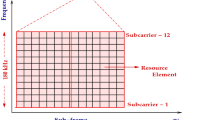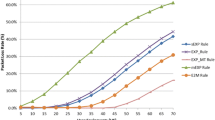Abstract
Long Term Evolution (LTE) systems will provide a large number of users with various high quality wireless Internet services including but not limited to voice over IP, real-time gaming, multimedia streaming and several others. A suitable pricing policy is an important component in order to bring benefits to both the operators and the customers. In fact, through this, the operator can efficiently manage the radio resources of cellular networks. For different types of services, the operator can maintain user Quality of Service and through which, the revenue can be optimized. This article analyzes various possible LTE pricing schemes, including the one proposed, based on different criteria: network load and congestion, operator revenue, traffic differentiation and user categorization. We provide comparative graphs to highlight the pros and cons of the studied pricing strategies. We highlight the importance for the operator to move from the often used flat-rate style policies towards more dynamic pricing strategies taking into account the user and service classes.







Similar content being viewed by others
Explore related subjects
Discover the latest articles, news and stories from top researchers in related subjects.References
Holma, H., & Toskala, A. (2011). LTE for UMTS: Evolution to LTE-advanced (2nd ed.). New York: Wiley.
Ku, G., & Walsh, J. M. (2015). Resource allocation and link adaptation in LTE and LTE advanced: A tutorial. IEEE communications surveys & tutorials, 17(3), 1605–1633.
OPENET White Paper. (2011). Guide to smarter data service tiers: Evolving tiered pricing for LTE & 3G+.
Yankee Group. (2009). Thinking beyond flat-rate and stove-piped business models.
Dasilva, L. A. (2000). Pricing for QoS-enabled networks: A survey. IEEE Communications Surveys & Tutorials, 3, 2–8.
Soldani, D., Jun, H. X., & Lück, B. (2011). Strategies for mobile broadband growth: Traffic segmentation for better customer experience. In IEEE VTC-Spring, Budapest (pp. 1–5) .
Wallenius, E., & Hamalainen, T. (2002). Pricing model for 3G/4G networks. In IEEE PIMRC, Lisbon (pp. 187–191).
Balbas, J.-J. P., Rommer, S., & Stenfelt, J. (2009). Policy and charging control in the evolved packet system. IEEE Communications Magazine, 47, 68–74.
Ouellette, S., Martinez, B., & Pierre, S. (2011). A potential evolution of the policy and charging control/QoS architecture for the 3GPP IETF-based evolved packet core. IEEE Communications Magazine, 49, 231–239.
Mir, U., & Nuaymi, L. (2012). Comparison of policy realization strategies for LTE networks. In 75th IEEE VTC-Fall, Quebec.
Ibrahim, W., Chinneck, J. W., Periyalwar, S., & El-Sayed, H. (2005). QoS satisfaction based charging and resource management policy for next generation wireless networks. In International conference on wireless communications, networking and mobile computing, WCNM’05, Wuhan (pp. 868–873).
Belghith, A., Nuaymi, L., & Maille, P. (2008). Pricing of real-time applications in WiMAX systems. In IEEE VTC-Fall, Calgary (pp. 21–24).
Motorola White Paper. (2011). LTE flat rate pricing for competitive advantage.
Mir, U., & Nuaymi, L. (2013). LTE pricing strategies. In IEEE VTC-Spring.
Jaber, M., Dawy, Z., Akl, N., & Yaacoub, E. (2016). Tutorial on LTE/LTE–A cellular network dimensioning using iterative statistical analysis. In IEEE Communications Surveys & Tutorials, 18, 1355–1383. (in print).
Wang, M., Zhang, J., Ren, B., Yang, W., Zou, J., Hua, M., et al. (2016). The evolution of LTE physical layer control channels: A tutorial. IEEE Communications Surveys & Tutorials, 18, 1336–1354. (in print).
Cheng, M. Y., Lin, G. Y., Wei, H. Y., & Hsu, A. C. C. (2012). Overload control for machine-type-communications in LTE-advanced system. IEEE Communications Magazine, 50(6), 38–45.
Soltanmohammadi, E., Ghavami, K., & Naraghi-Pour, M. (2016). A survey of traffic issues in machine-to-machine communications over LTE. IEEE Internet of Things Journal, 3, 865–884. (in print).
Zheng, K., Hu, F., Wang, W., Xiang, W., & Dohler, M. (2012). Radio resource allocation in LTE-advanced cellular networks with M2M communications. IEEE Communications Magazine, 50(7), 184–192.
Laya, A., Alonso, L., & Alonso-Zarate, J. (2014). Is the random access channel of LTE and LTE—A suitable for M2M communications? A survey of alternatives. IEEE Communications Surveys & Tutorials, 16(1), 4–16.
Gotsis, A. G., Lioumpas, A. S., & Alexiou, A. (2012). M2M scheduling over LTE: Challenges and new perspectives. IEEE Vehicular Technology Magazine, 7(3), 34–39.
Morvari, F., & Ghasemi, A. (2016). Two-stage resource allocation for random access M2M communications in LTE network. IEEE Communications Letters, 20, 982–985. (in print).




